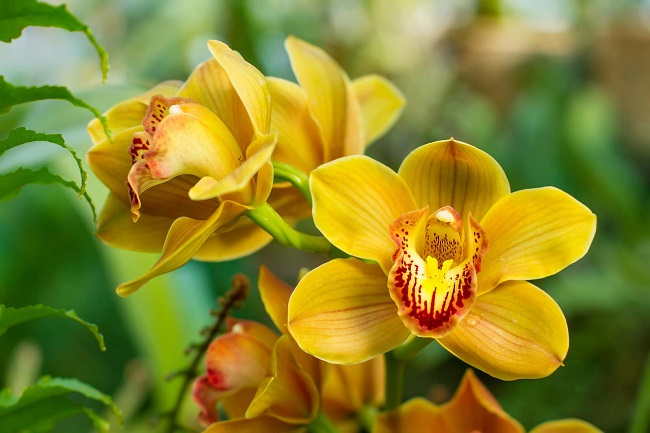
Most of us have no doubt seen, whether in a grocery store or big box market, big (and I mean big) beautiful Cymbidium plants in full bloom with perhaps 2, 3 or maybe 4 spikes of rank and file flowers in full regalia. The reality is, unless you can provide cool growing conditions for these beauties year-round, your chances of growing a healthy specimen, let alone getting it to bloom, is pretty slim. Depending on where you live, it’s not impossible, but it is slim, nonetheless.
But do not despair. A recent insurgence in interest of so-called Warm Growing Cymbidiums has created a delight in the hearts of those who simply cannot meet the cool growing requirements of the standard cool growing Cymbidium. Modern hybridizing, particularly with the warm growing species of the world from India, southern China, Malaysia, Australia, Philippines etc., has created some fabulously beautiful blooms and smaller plants that will tolerate the typical warm greenhouse conditions. Though the blooms are not usually as large as the standard Cymbidium, pollen from various large flowered (cool growing) hybrids have been used extensively to produce blooms that are still sizable enough to be very impressive, without having the massive overall plant size of their cool growing cousins. Very often, depending upon which Chinese specie is used in hybridization, the flowers of the warm growers can be very fragrant and as a bonus, the plants can sometimes bloom more than once a year, standard Cym’s will bloom only once per year, provided they receive drastic reduction in nighttime temperatures during spike initiation.
Plants to look for from Orchid nurseries include, Cym. Amy Chen “Chens Ruby” a lovely red bloom, Cym. Peter Pan “Greensleeves”, a well-known green and fragrant hybrid that has the capability to bloom all year long just to mention a few of perhaps hundreds of other hybrids and clones.
Quick Culture Tips
Light
As much as they will take without scorching, leaves should be a light grassy yellow green color. Too much shade is the most common cause of non-blooming Cymbidiums.
Water – Humidity – Temperature
During their active growth period of March through September, Cymbidiums require much more water, with excellent drainage. Temperatures suitable for Cattleya’s (or higher, tolerant up to 110°) will be fine for the warm growing Cymbidiums, just be sure to provide good air movement. Humidity should hover around 50% at least. Fertilize heavily with a good all-purpose fertilizer.
Give them a try, you will be completely delighted!
Tom Capranica has been a hobby collector and hybridizer of Orchids for over 20 years, and an active member of the American Orchid Society (AOS) for about the same length of time. He grows his Orchids in a 450 sq. ft. climate-controlled greenhouse, containing over 300 plants of various genera, primarily Cattleya.
Related Articles & Free Email Newsletter
4 Mistakes to Avoid with Dendrobium Orchids
4 Tips for Growing Young Orchids



Comment here